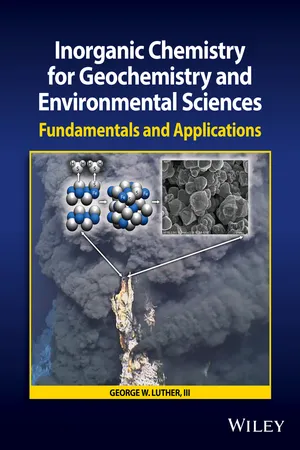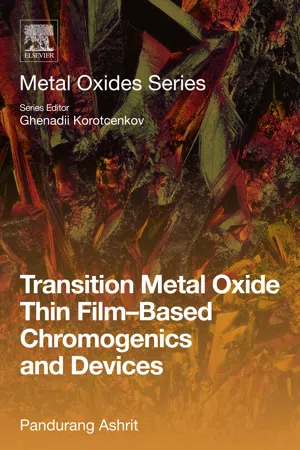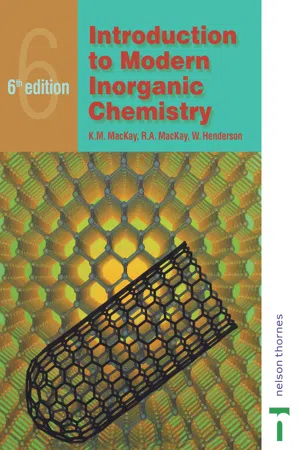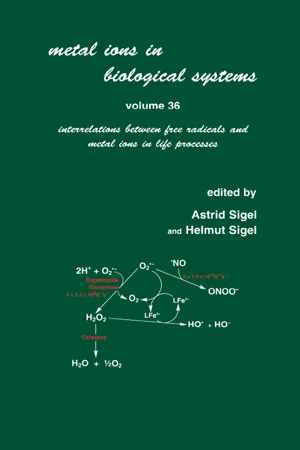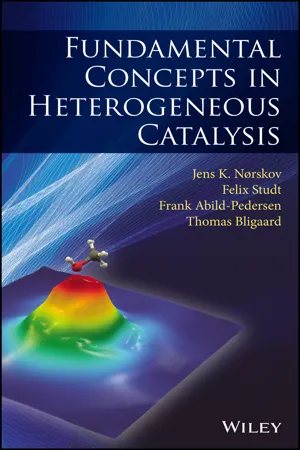Chemistry
Variable Oxidation State of Transition Elements
Transition elements exhibit variable oxidation states due to the presence of incompletely filled d orbitals in their electronic configurations. This allows them to lose or gain different numbers of electrons, resulting in multiple oxidation states. The variable oxidation states of transition elements make them versatile in forming a wide range of compounds and participating in various chemical reactions.
Written by Perlego with AI-assistance
Related key terms
Related key terms
1 of 4
Related key terms
1 of 3
5 Key excerpts on "Variable Oxidation State of Transition Elements"
- eBook - ePub
Inorganic Chemistry for Geochemistry and Environmental Sciences
Fundamentals and Applications
- George W. Luther(Author)
- 2016(Publication Date)
- Wiley(Publisher)
(an inner sphere electron transfer process).10.2 Factors Governing Metal Speciation in the Environment and in Organisms
Many factors affect the reactivity of a metal ion in the environment. Section 1.8.2 indicated that the oxidation state of a metal [e.g., Fe(II) versus Fe(III)] depends on the redox condition of the environment. For example, once dissolved and are consumed, microbes decompose organic matter with other oxidants such as and FeOOH, resulting in reduction to and . Metal ions can exist as inorganic complexes with the following common inorganic ligands: chloride, carbonate, sulfate, phosphate, and sulfide. However, there are a variety of organic ligands that are naturally produced and that outcompete the inorganic ligands for bonding with metal ions. Ligands also affect the redox and spin state of a metal couple such as Fe(III)/Fe(II) (Section 8.7.3 for Co; Table 10.1 for Fe), and nature uses ligand–metal bonding to affect reactivity and catalysis. The left of Figure 10.1 shows potentials for several reduction couples that are important in life processes (sometimes termed a redox spectrum). An oxidized partner of a redox couple at the top such as can be reduced by the reduced partner of any couple below it as . Thermodynamically, the couple is one of the most efficient, but it also shows the energy needed for water splitting (the reverse reaction that requires photochemistry; Section 10.7 ). The FeS proteins (see Section 12.6.4 ) have different oxidation states and ligand attachments that tune their redox potential over 1 volt; reduction of to is possible for some redox centers (ferredoxins). Selected aspects of the redox chemistry for the metal redox centers in Figure 10.1 are described below and in Chapter 12 - Pandurang Ashrit(Author)
- 2017(Publication Date)
- Elsevier(Publisher)
d electrons in its outer shell.The interesting properties in these oxides stem from these outer or frontier d electrons. For example, as per the scheme of filling the electronic orbits, the element tungsten (W), with an atomic number of 72, has the following electronic configuration: 1s 2 2s 2 2p 6 3s 2 3p 6 4s 2 3d 10 4p 6 5s 2 4d 10 5p 6 6s 2 4f 14 5d 4 . Hence, this leads to the facile formation of the trioxide of tungsten (WO3 ) by sharing the six outer electrons with three oxygen atoms, shell 6 with two electrons in subshell s and the outermost shell (5) with four electrons in subshell d . The W atom becomes W6+ and each oxygen atom becomes O2−. Similarly, vanadium dioxide (VO2 ), with vanadium's atomic number of 23 and electronic configuration of 1s 2 2s 2 2p 6 3s 2 3p 6 4s 2 3d 3 , is formed by giving off two of its electrons from subshell 4s and two from the 3d subshell. The vanadium atom thus becomes V4+ and each oxygen atom becomes O2−. Thus, in all the TMOs it is these outer d bands and the oxygen p bands that are the most significant in determining the electronic properties of TMOs. In addition to this oxide formation with a single or multiple transition element it is possible to have other alkaline or rare earth metal atoms that can also provide the needed electrons to the oxygen atoms. A wide range of transition metal-based oxides can thus be formed from the simple monoxides (MO) to the complex oxides of the form Rx Mm On , where M represents the transition metal and R can be any other suitable atom that can be included. These TMOs can thus be created by adjusting the number of each atom in the compound (x , m , n ) and having different numbers of electrons in the outer d bands of the transition metal. This variation in the number of electrons in the d- R.A. Mackay(Author)
- 2017(Publication Date)
- CRC Press(Publisher)
Table. 8.3 are thermodynamic and there is no information about the rates of reactions. Thus a state may be thermodynamically unstable but persist in solution because its rate of reaction or disproportionation is slow. Similarly, the potential data apply only to systems in equilibrium, and the rate of attaining equilibrium may be slow. This applies particularly to systems involving solids—for example, an element. Many elements which are strongly reducing react only very slowly due to surface effects and the like. Throughout the later chapters, curves are plotted for potential data in acid solution, at a pH of 0. Similar data are available for alkaline solution, and a set of equivalent curves could be drawn for such media. These are less useful as many more states appear as solids (as hydroxides or hydrated oxides) in alkali.The occurrence and stability of the solid halides, oxides and sulfides of the elements, taken together with the free energy diagrams linking the different oxidation states, gives an adequate guide to the general chemistry of an element in its common compounds. In general, a stable state may be assumed to form compounds with all the common anions and ligands—all the oxyanions, pseudohalides, organic acid anions, hydride, nitride, carbide, amide, sulfur anions and so on. Unstable states will form a much more limited set of compounds, down to those states represented by only one or two examples. A state which is unstable and oxidizing will form no compounds with oxidizable ligands such as nitrite or organic groups, and similarly, a reducing state will form no compounds with oxidizing ligands, as with the chlorite and chlorate compounds of iron mentioned above. By avoiding cataloguing such compounds of the elements, space is preserved for the mention of the more unusual compounds formed and as many of these as possible have been discussed in the later chapters which may be regarded as an introduction and supplement to the systematic chemistry given in the major inorganic textbooks which are listed in the reading lists.8.7 The abundance and occurrence of the elements
One of the most satisfying scientific constructs of the second half of the 20th century was the picture of the genesis of the elements. Once 19th-century chemists had discovered that each element emitted a distinctive spectrum when heated, the way was open to identify elements in the stars by their spectral lines. In this way, helium (from the Greek hellos, sun) was found in the solar spectrum about a decade before it was discovered on Earth. Such studies led to the evaluation of the abundance of the different elements in the Universe and a striking picture emerged. Hydrogen and helium together account for about 99% of the mass of the Universe and over 99.9% of the atoms. At the other extreme, the heaviest elements are present to the extent of about 10−12- eBook - ePub
Metal Ions in Biological Systems
Volume 36: Interrelations Between Free Radicals and Metal Ions in Life Processes
- Astrid Sigel, Helmut Sigel(Authors)
- 2018(Publication Date)
- CRC Press(Publisher)
4 Free Radicals as a Source of Uncommon Oxidation States of Transition MetalsGeorge V. Buxton1 and Quinto G. Mulazzani21 Centre for Joint Honours in Science, University of Leeds, Leeds LS2 9JT, UK2 Istituto di Fotochimica e Radiazioni d’Alta Energia del C.N.R., 40129 Bologna, Italy1. INTRODUCTION 1.1. Nature of the Species 1.2. Interaction of Free Radicals with Transition Metal Ions 2. PROPERTIES OF FREE RADICALS 2.1. Acid-Base Forms and Reduction Potentials 3. GENERATION OF FREE RADICALS 3.1. Radiolysis of Water 3.2. Photolysis 3.3. Generation of Secondary Radicals in Water Radiolysis 4. MEASUREMENT OF REACTION RATES 5. INTERACTION OF FREE RADICALS WITH SIMPLE TRANSITION METAL IONS 6. INTERACTION OF FREE RADICALS WITH COMPLEXED TRANSITION METAL IONS 6.1. Reduction of the Metal Center 6.2. Oxidation of the Metal Center 6.3. Addition to the Metal Center 6.4. Reaction at the Ligand 6.4.1. Electron Transfer 6.4.2. Addition 6.4.3. Hydrogen Atom Abstraction 7. CONCLUSIONS ABBREVIATIONS REFERENCES 1. INTRODUCTION 1.1. Nature of the SpeciesFree radicals and transition metal ions are ubiquitous in biological systems. The variable valency of transition metal ions plays a key role in the catalysis of redox processes in which the oxidation states of the metal are inherently unstable and/or have only a transient existence during the reaction sequence. In many cases where the overall reaction involves multiple electron transfer, the detailed mechanism frequently comprises a sequence of one-electron steps. Free radicals, being atoms or molecules with an unpaired electron, are the archetypal one-electron redox reagents, so that the elementary step in the interaction of free radicals with transition metal ions is a one-electron process. The elucidation of the complex mechanisms that take place in nature can be advanced to a great extent if one is able to measure in isolation these individual steps. To achieve this goal use is made of the fast time-resolved methods of pulse radiolysis and flash photolysis to generate the desired free radicals and to measure their rates of reaction with the species of interest. Often these species are model compounds rather than the biological systems themselves. - eBook - ePub
- Jens K. Nørskov, Felix Studt, Frank Abild-Pedersen, Thomas Bligaard(Authors)
- 2014(Publication Date)
- Wiley(Publisher)
d-band center. We end the chapter by indicating that similar concepts can be developed to understand trends in reactivity for transition metal compounds. The point to realize is that if there is a high concentration of electronic states with energies within a few eV (the order of magnitude of adsorbate–surface coupling matrix elements) of the Fermi level, they are likely to dominate variations in reactivity because they can interact with the adsorbate states and form occupied bonding and unoccupied antibonding states.Consider oxygen adsorption on transition metal oxide surfaces. The role of the narrow bands of metal d-states in the transition metals is now played by localized surface resonances and surface states, typically in the gap of semiconducting or insulating transition metal oxides.This is illustrated in Figure 8.21 a where we consider TiO2 doped with different transition metals. Doping leads to new d-derived surface states as shown for Cr-doped TiO2 in Figure 8.21 b, and the adsorption energy of O atoms scales with the energy of these states.(a) Correlation between oxygen adsorption energies and the center of the d-projected surface and resonance states on doped TiO2 . The upper solid line is a best linear fit to the DFT calculations, and the lower solid line the best linear fit to DFT + U calculations. (b) Atom-specific projected DOS for Cr-doped TiO2 .Figure 8.21Adapted from Garcia-Mota et al. (2013).References
- Abild-Pedersen F, Greeley J, Nørskov JK. Understanding the effect of steps, strain, poisons, and alloying: methane activation on Ni surfaces. Catal Lett 2005a;105:9–13.
- Abild-Pedersen F, Lytken O, Engbæk J, Nielsen G, Chorkendorff I, Nørskov JK. Methane activation on Ni(111): effects of poisons and step defects. Surf Sci 2005b;590:127–137.
- Andersson MP, Bligaard T, Kustov A, Larsen KE, Greeley J, Johannesen T, Christensen CH, Nørskov JK. Towards computational screening in heterogeneous catalysis: paretooptimal methanation catalysts. J Catal 2006;239:501–506.
Index pages curate the most relevant extracts from our library of academic textbooks. They’ve been created using an in-house natural language model (NLM), each adding context and meaning to key research topics.
Explore more topic indexes
Explore more topic indexes
1 of 6
Explore more topic indexes
1 of 4
